Flat tires remain one of the most common and disruptive problems drivers face on the road. Even a short trip can come to a sudden stop because of unnoticed damage or a small pressure leak. Some causes happen without warning, while others build up over time due to wear, neglect, or changing conditions. Every flat tire has a specific reason behind it, and knowing those reasons helps reduce the risk and prepare for unexpected breakdowns.
Several factors can lead to air loss, punctures, or full blowouts. Not all flats result from a nail in the road. Some involve hidden damage to the rim, worn-out rubber, or small cracks that allow air to escape slowly. A sharp curb, temperature drop, or aging tire can all trigger a sudden drop in pressure.
Each reason has a solution and a warning sign that helps spot the danger early. By knowing what to check and how each issue works, drivers can avoid surprise flats and keep their tires in top shape.
1. Nail, Screw, or Sharp Debris Pierced the Tread

A flat tire caused by a sharp object shoved into the tread is the most frequent roadside issue. Nails on construction routes, broken glass in parking lots, or screws on highways end up buried in the rubber, usually without you noticing.
If the object stays lodged, air escapes slowly. If it falls out, the tire deflates fast. The deeper the puncture, the worse the outcome. A clean puncture dead center in the tread might get repaired. Anything closer to the shoulder or sidewall means the tire cannot be trusted anymore.
Can the Tire Be Saved After a Puncture?
Yes, if the puncture stays in the middle tread and the hole measures under 1/4 inch. Tire shops use a combination plug-patch that seals from inside. If the hole touches the sidewall or shoulder curve, no fix is safe. That tire belongs in the trash.
How Much Does a Plug-Patch Fix Cost and Is It Worth It?
You pay around $25 to $40 at most shops. That includes removal, patching, balancing, and mounting. For tires still within legal tread depth, this fix saves you a full replacement. Anything with uneven wear or close to bald tread does not justify repair.
2. Bent or Corroded Rim Broke the Bead Seal
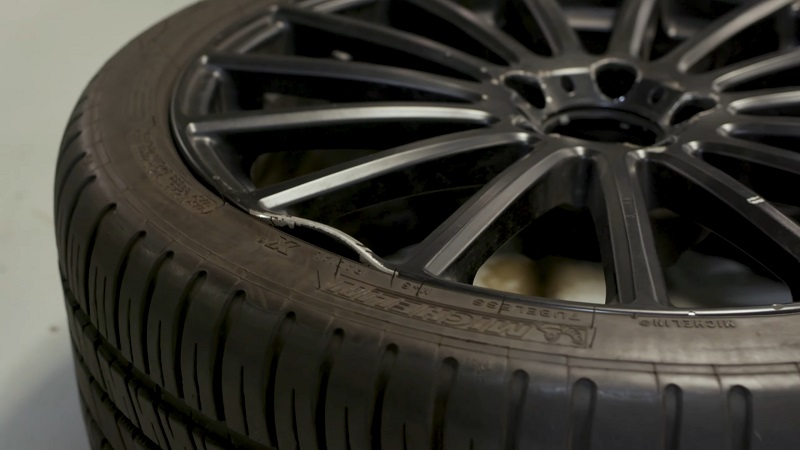
A flat caused by rim damage happens more than people think. The bead seal where the tire edge meets the wheel must stay tight. When the rim bends from pothole impact or corrodes due to road salt, that seal breaks. Air escapes without warning.
The leak may be slow at first, then trigger sudden deflation if the car hits another bump. Corrosion looks like white chalky buildup or rust around the rim lip. Bent rims cause vibration, tire wobble, or repeated flats even after reinflation.
Can the Bead Seal Be Repaired?
Only if the rim edge shows mild corrosion or dirt buildup. Shops can clean and reseal it. A bent rim might get straightened by a specialist. But not all shops handle aluminum rim repair. Severe cracks or dents ruin the rim’s structure. That calls for replacement.
What Does Rim Repair or Reseal Cost and Should You Bother?
Bead resealing costs about $25 to $35. Rim straightening starts around $80 and can hit $150 or more for larger wheels. Rims with heavy damage weaken the tire hold. If the same tire keeps going flat every few weeks, stop wasting money. Replace the wheel.
3. Valve Stem Leaked or Snapped Off
A valve stem handles all the air movement in and out of your tire. That small part breaks down due to age, sun, weather, or physical stress. Plastic caps go missing, rubber dries out, and cracks form where the stem meets the wheel. If the pin inside sticks or bends, it leaks air constantly.
In other cases, the entire stem snaps after contact with a rock or careless handling. That causes immediate deflation. Most drivers do not even look at their valve stems until the problem shows up.
Should You Replace or Repair a Faulty Valve Stem?
Always replace it. There is no reliable way to fix a cracked or leaking stem. The shop removes the tire and installs a new one. Many use rubber snap-in stems, but metal stems appear on high-end vehicles or TPMS systems. Both types need full swap once damaged.
How Much for a New Valve Stem and Does It Make Sense?
Rubber valve stem replacement runs $10 to $25. Metal ones with sensors can go up to $60 or more depending on the model. If you catch it early and the tire holds full pressure otherwise, replacing the stem saves the tire. If the stem broke while driving and the tire got shredded, replacement is your only option.
4. Massive Blowout After Hitting a Pothole or Curb
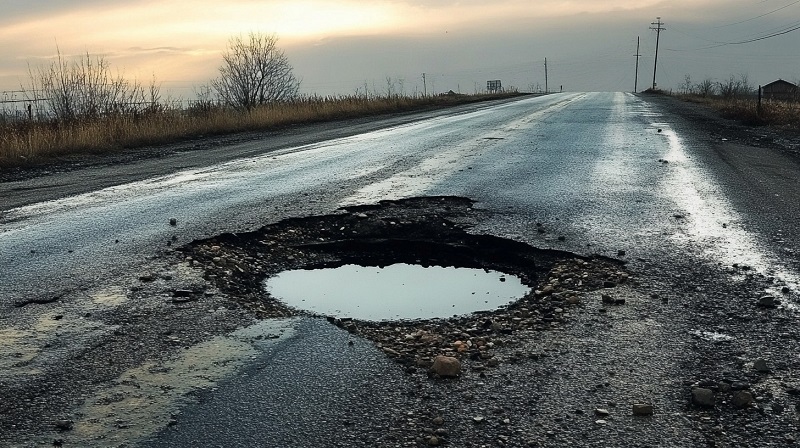
A hard strike against a pothole or sharp curb causes an immediate tire failure. That impact crushes the sidewall or pinches the rubber between the rim and pavement. The tire does not leak slowly. It explodes or tears.
No repair works after this kind of failure. The sidewall becomes deformed, shredded, or fully ripped open. Even if the tire holds shape afterward, internal damage already exists and creates a blowout risk with any future pressure buildup.
What Happens After a Sidewall Blowout?
You walk. The tire gets replaced. Period. No patch, no plug, no sealant can fix a destroyed sidewall. Shops will refuse to touch it. Driving on a blown-out tire destroys the rim too. Always stop the car immediately.
Cost of Replacement and Long-Term Risk
Replacement costs range between $100 and $250 depending on size and brand. If the blowout caused rim damage or alignment issues, expect an added $100 or more. Ignoring the cause (usually underinflation or aged rubber) puts every other tire at risk. Always check pressure and inspect tread depth after a blowout.
5. Tire Dry Rot and Cracked Sidewalls
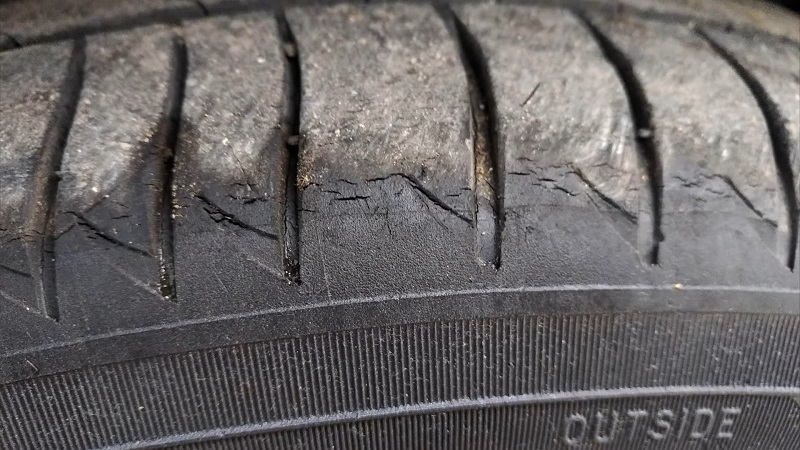
Tires age, even unused ones. Sunlight, oxygen, and heat break down rubber over time. Dry rot looks like small spiderweb cracks on the sidewall or between tread blocks. The surface gets stiff, loses flexibility, and splits apart under stress.
A dry rotted tire can blow out on the highway or deflate slowly as cracks grow. Garage-stored cars, trailers, or weekend vehicles often suffer from this without obvious signs. Age, not mileage, causes the failure.
Can You Drive on Dry Rotted Tires?
No. Any visible cracks mean the internal rubber bonds have already weakened. Even if the tread looks fine, those cracks signal tire death. A shop may refuse to service cracked tires due to liability. Replace them before they fail in motion.
Age, Cost, and Timing: When to Let Go
Rubber lasts 6 years at most. Check the DOT code on the sidewall to find the build date. Four-digit number tells week and year (e.g. 3219 = 32nd week of 2019). If the tire hits 5 years and shows surface cracks, replacement makes more sense than risking high-speed failure. Cost depends on size, but letting go early prevents expensive roadside towing and rim damage.
6. Underinflation Destroyed the Sidewall from Inside
Driving with low pressure bends and flexes the tire more than it was built to handle. That movement overheats the inner structure. The sidewall breaks down internally even if it looks fine on the outside. At some point, the weakened rubber gives out.
It may bulge, blow out, or peel away in layers. Long trips on soft tires cause the most damage. Drivers rarely notice the problem until the tire collapses completely or starts making a thumping noise.
Can Internal Damage Be Spotted or Fixed?
You cannot see internal fiber failure. A tire shop will spot sidewall bulges, heat bubbles, or delamination. If any of those show up, the tire cannot be saved. Damage hides behind the outer rubber and reveals itself only under full inflation.
Pressure Neglect Becomes Expensive Fast
Driving just 10 psi under normal for a few days weakens the whole sidewall. A replacement will cost between $120 and $220. Add $80 if you need a tow. If one tire failed from underinflation, always check the others. Low pressure ruins fuel economy, steering control, and safety. Buy a gauge. Check weekly. No excuse.
7. Blowout from Tire Separation or Internal Tread Failure
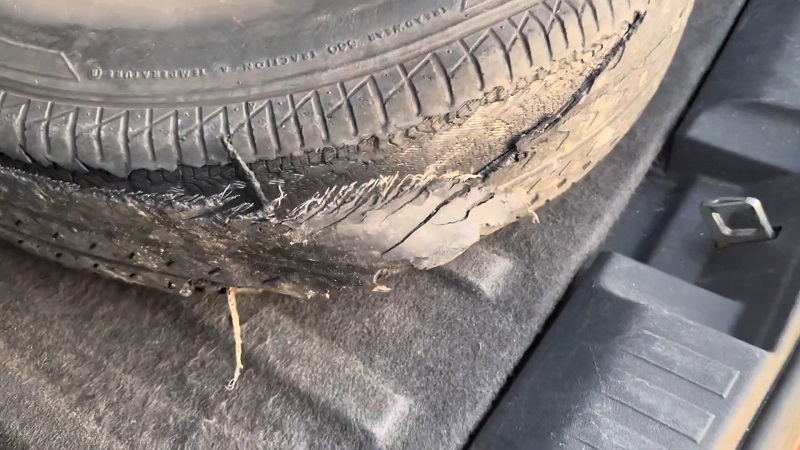
Tire separation happens when the internal layers of the tire casing come apart. That usually starts with heat, high-speed driving, or defective bonding during manufacturing. Sometimes it begins after hitting a curb or driving underinflated for too long.
When the tread starts peeling away from the tire body, you feel a strong vibration. Then comes the blowout. It always happens fast. In some cases, the entire tread belt comes off, leaving only the inner rubber shell on the rim.
Once the Tread Starts to Peel, Can the Tire Be Used?
No. Separation means death. There is no patch, glue, or rebuild that will restore a peeled tire. Even if you stopped before the blowout, the layers are already unstable. Replace it immediately.
Tread Separation Always Costs More Than Just a Tire
Besides the $150 to $250 for the tire, separation often destroys the fender, wheel well, or suspension. If the tread smashes into the underside of your car at high speed, expect repairs over $500. Never ignore steering shake or loud thumping. That’s your only warning.
8. Rim Crack Caused Hidden Air Loss
A cracked rim causes pressure to drop slowly or suddenly, depending on the location of the damage. Cracks appear near the lip, spokes, or weld seams. Hitting a sharp pothole or running on a flat tire often triggers the crack.
In many cases, the leak only happens when the wheel flexes during driving. Parked cars may show full pressure, then lose it during motion. This failure often gets misdiagnosed as a tire leak when the tire is still perfect.
Can Cracked Rims Be Welded Safely?
Some rim cracks can be welded, but only if located away from the bead and not on structural points. A specialist must assess the wheel and pressure-test it afterward. If the crack runs deep or touches the edge where the tire seals, that rim goes to scrap.
Rim Welding Costs Add Up Fast
Welding a crack costs between $50 and $400 depending on location and material. But if the rim fails again or warps during welding, you wasted money. Buying a new wheel often makes more sense unless you drive a rare or high-end vehicle with expensive factory rims.
9. Air Leaked Due to Poor Tire Mounting
Mounting errors cause slow leaks and weak bead contact. A rushed or careless tire tech might pinch the bead, misalign the seal, or trap dirt during installation. If the bead fails to seat evenly, it never seals right.
That creates a leak even without visible damage. Some mounting machines also scratch or tear the inner liner, which leaks under pressure. Most people blame nails, but poor mounting causes just as many flats.
What Can Be Done If the Mounting Was Faulty?
The tire must be fully removed and inspected for pinches or inner liner tears. The bead area gets cleaned, and the shop redoes the seal with proper lubricant and pressure. If the bead got sliced, that tire is garbage. No repair exists for torn bead rubber.
A Mounting Mistake Can Become an Expensive Habit
Remounting costs between $20 and $35. But repeated leaks waste time and air. If the same shop keeps producing bad seals, go elsewhere. A bad mount today becomes a flat tomorrow. Keep your invoice and demand a proper balance and reseal if air keeps escaping without visible puncture.
10. Rapid Deflation Caused by Tire Bead Wire Break
The bead contains a steel wire that wraps around the rim to hold the tire in place. That wire can snap if the tire flexes too far due to underinflation or a harsh impact. Once the bead wire breaks, the tire cannot stay seated on the rim. Air escapes all at once.
Sometimes it happens while parked. Other times it bursts out at low speed with a loud pop and full pressure loss. This issue almost always ruins the tire instantly.
Is a Broken Bead Wire Repairable in Any Case?
No. The bead wire is buried deep under layers of rubber. Once it breaks or separates, the tire has no structural lock to hold air. Even if it looks intact, air will never stay in for long. The tire is finished.
Wire Breakage Turns into Full Tire Replacement Cost
You will spend the full cost of a replacement—usually $120 to $180. Sometimes you also need a rim cleaning or reseal job to fix scuff marks caused by the snap. Driving with underinflated tires for too long is the most common trigger. Once the bead fails, that tire belongs in a dumpster.
11. Aluminum Corrosion Let Air Escape Around the Rim
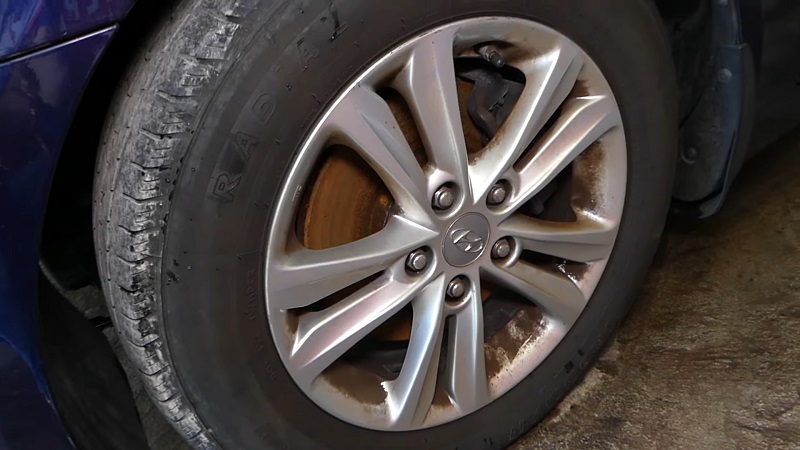
Aluminum rims corrode over time, especially in cold climates or areas with salted roads. That corrosion forms white powdery buildup under the tire bead. As the rim corrodes, it creates tiny gaps that break the seal and allow air to escape.
Even light corrosion can lead to a slow leak that repeats no matter how many times the tire gets inflated. Sometimes the air loss takes days. Other times, it drops overnight.
How to Handle a Corroded Bead Seat
A tire shop can remove the tire and clean the rim surface with a wire brush or grinder. They then apply bead sealer paste to restore the seal. That works if the corrosion stays shallow. If the pitting goes deep, the rim becomes unusable.
Cleaning Works, But Only If Caught Early
Bead cleaning and resealing costs $20 to $40. If the damage extends beyond surface corrosion, the rim replacement starts at $100 and can go higher for larger wheels. If your tire keeps losing air and no nail is found, always check for rim corrosion.
12. Heat Buildup from High-Speed Driving Caused a Blowout
Driving at high speeds with low air pressure or worn tires causes massive heat buildup. That heat destroys the internal structure of the tire. Layers separate. Sidewalls weaken. Eventually, the tire explodes.
Blowouts from heat usually happen on highways or long summer trips. Once the tire fails, the vehicle swerves or loses control unless you react fast.
What Warning Signs Show Heat Is a Problem?
You might notice a soft tire feel, steering pull, or rising vibration before it pops. If the tire shows bubbles or smells hot, stop immediately. Damage at that point is irreversible.
Speed + Heat = Full Replacement and Risk
You pay $150 to $250 for a new tire. If the blowout damages your fender, expect another $200 or more. Driving with proper pressure, especially on long trips, is the only way to stop heat-related failures. Never rely on visual checks alone. Use a gauge.
13. Tread Wore Down to the Cords
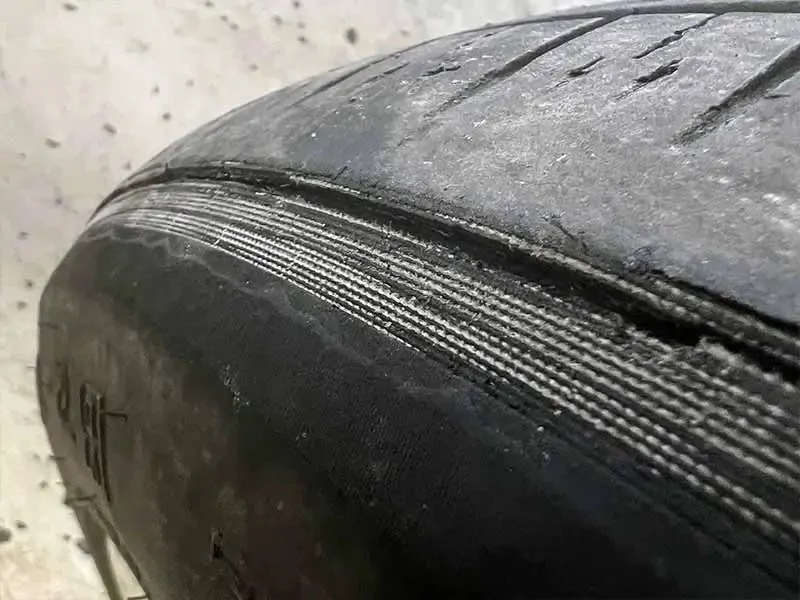
Driving on bald tires exposes the inner layers to direct contact with the road. Once the tread disappears, the next layer—called the cords—becomes visible. Those cords tear easily under stress.
Even a light impact or temperature shift can cause a sudden flat. When the cords start showing, air loss follows fast. That tire has already failed, even if it holds air for now.
Can a Cord-Exposed Tire Ever Be Used Again?
No. That tire is legally and structurally done. It no longer meets road safety standards. No shop will patch or remount a cord-exposed tire. The rubber cannot protect against impact or heat anymore.
Bald Tires Lead to Fines, Accidents, and Full Cost
A new tire costs $120 to $220 depending on size. Driving on cords can lead to traffic fines in many states. More importantly, one bad tire ruins traction, braking, and control. Never drive until the tread disappears.
14. Sudden Drop in Temperature Dropped Pressure Below Safe Level
Cold weather causes tire pressure to fall fast. Every 10°F drop cuts about 1 psi. In extreme cases, tires go flat overnight. The rubber also stiffens in the cold, which weakens the seal at the bead and valve.
If your tires were already borderline low, freezing temperatures finish the job. Flat tires on cold mornings are a common winter surprise.
Can Cold Alone Cause a Flat Tire?
Yes. If the tire pressure was already too low, cold air finishes the drop. Combine that with old rubber or weak seals, and full deflation happens overnight. Regular pressure checks prevent the problem before it starts.
Cold Weather Tire Checks Save Money and Trouble
A flat caused by cold often still saves the tire, as long as no rim damage occurred. Shops may refill and inspect for $10 to $15. But ignoring the problem leads to a crushed sidewall and a $150 replacement. Always inflate to manufacturer pressure before cold fronts hit.
Last Words
Flat tires never happen at a good time. Each cause brings its own warning signs, damage level, and cost. Knowing what triggers the failure helps avoid repeat problems, wasted repairs, or unsafe driving. Some flats trace back to one nail. Others come from silent damage building up over weeks.
Pressure checks, tread inspections, and rim maintenance prevent most flats before they start. Ignoring signs like slow leaks, sidewall cracks, or uneven wear always leads to a bigger bill later. If the damage already happened, stop guessing. Let a shop inspect it, and do not gamble with patch jobs when the structure is gone.
